


BRITAIN OUTLAWS THE SLAVE TRADE
1807 (G3c)
xxxxxThe Portuguese began the
trade in West African slaves around 1444, but the Trans-Atlantic
trade started in the first years of the 16th century. As we have
seen by the Asiento de Negros of 1713 (AN), this was a
despicable, degrading, traffic which took some 8 to 15 million
Africans to work in the New World. The Quakers were the first to
protest. In Britain, a Society for the Abolition of the Slave Trade
was established in 1787, mainly the work of the philanthropist
Granville Sharp and the cleric Thomas Clarkson, assisted by the
pottery manufacturer Josiah Wedgwood. A nationwide campaign was
launched, and gained the support of men such as John Wesley, William
Pitt, Edmund Burke and Charles Fox. The fight in Parliament was led by the brilliant orator
William Wilberforce. After many attempts to obtain legislation,
Britain outlawed the slave trade in 1807. As we shall see, however, it was not until 1833 (W4) that slavery was
banned in British colonies. Some European nations, such as Denmark,
had condemned slavery much earlier, but it was not until 1870 that
most others had followed suit. In the United States the northern
states opposed the slavery in the deep South, and this antagonism
gained momentum with the publication of Uncle
Tom’s Cabin by Harriet Beecher Stowe in 1852. It took the
American Civil War, ten years later, to settle the issue.
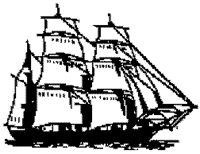 xxxxxThe trade in
West African slaves was begun by the Portuguese as early as 1444,
during their expeditions along the west coast of Africa. The Trans-Atlantic
trade by which young West Africans were transported to the New
World, began as a trickle in 1502 but, over the years, grew into a
vast torrent, stimulated by the growth of the plantation system.
Slavery had been a factor in life, of course, since the earliest
“civilisations”, but the trade across the Atlantic was particularly
degrading, harsh and inhuman, if only because of the dreadful
conditions which had to be endured - and were often not endured
- on the long outward sea journey. It was a traffic in misery
which, as we have seen by the Asiento de Negros
of 1713 (AN),
had reached enormous proportions by the beginning of the 18th
century.
xxxxxThe trade in
West African slaves was begun by the Portuguese as early as 1444,
during their expeditions along the west coast of Africa. The Trans-Atlantic
trade by which young West Africans were transported to the New
World, began as a trickle in 1502 but, over the years, grew into a
vast torrent, stimulated by the growth of the plantation system.
Slavery had been a factor in life, of course, since the earliest
“civilisations”, but the trade across the Atlantic was particularly
degrading, harsh and inhuman, if only because of the dreadful
conditions which had to be endured - and were often not endured
- on the long outward sea journey. It was a traffic in misery
which, as we have seen by the Asiento de Negros
of 1713 (AN),
had reached enormous proportions by the beginning of the 18th
century.
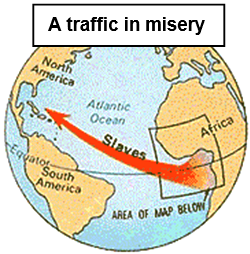
xxxxxThe Asiento
de Negros was a contract concerning the supply of slaves.
Initiated by the Spanish early in the 16th century, it was a
monopoly granted for the supply of Africans to work in the American
Spanish colonies. It is estimated that by this system alone some
450,000 Africans were transported to Spanish America between 1600
and 1750. But this was but a small percentage of the overall total.
From the middle of the 16th century until 1870, when the trade
virtually came to an end, it is thought that 8 to 15 million
Africans were forcibly taken to the New World. The vast majority
came from West and Central Africa, and most were put to work in the
Caribbean islands, the Guianas, and the Portuguese territory of
Brazil (some 40 percent alone). By comparison, only a small number
were settled on mainland Spanish America and in the former American
colonies.
xxxxxIn North America, as
in England, the first organised denunciation of slavery came from
the Quakers in the 1720s. At least by then an increasing number of
colonists were coming to regard it as an evil, necessary though it
might be. Indeed, in 1774 Rhode Island became the first state to
abolish slavery, and the other Northern states soon followed, but in
1788 the U.S. Constitution accepted that in the southern states it
would remain a fact of life, at least for the next twenty years. In
these states slavery had become such an integral part of the
agricultural and social economy, that its abolition was not seen as
a possibility, especially after the introduction of Eli Whitney’s
cotton gin, an invention of 1793 which required a vast increase in
the number of field hands in the plantations.
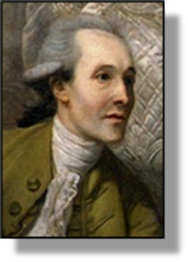
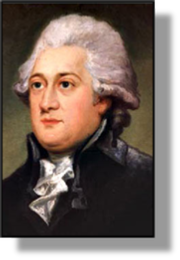 xxxxxIn Britain, the Quakers had campaigned against the slave
trade for many years, and had presented petitions to Parliament in
1783 and 1787. However, the first positive step was taken in 1787
with the establishment of the Society for
the Abolition of the Slave Trade. It was
formed by the English philanthropist Granville
Sharp (1735-1813) (illustrated
left), and the English cleric Thomas Clarkson (1760-1846)
(illustrated right),
together with the English pottery manufacturer Josiah Wedgwood, a
man passionately interested in social reform. Of the twelve members
on the committee, nine were Quakers. Pamphlets and books supporting
this cause were widely distributed; agents and committees were set
up across the country; and for many years Clarkson toured the land
as a fact finder, collecting statements and equipment - such as
leg-shackles and branding irons - as evidence against the
trade. Much of this material was used by Wilberforce in his speeches
in the Commons. At this time, too, his Essay on
the Slavery and Commerce of the Human Species, published in
1786, gained the sympathy of many, including John Wesley, William
Pitt, Edmund Burke and Charles Fox. In addition, use was again made
of petitions to parliament. In the nationwide campaign of 1792, for
example, over 500 - containing some 400,000 signatures -
were presented to the Commons, coming from Scotland and Wales as
well as every county in England. And, as we have seen, the
autobiography The Life of Olaudah Equiano,
the African, published in 1789, proved
immensely influential.
xxxxxIn Britain, the Quakers had campaigned against the slave
trade for many years, and had presented petitions to Parliament in
1783 and 1787. However, the first positive step was taken in 1787
with the establishment of the Society for
the Abolition of the Slave Trade. It was
formed by the English philanthropist Granville
Sharp (1735-1813) (illustrated
left), and the English cleric Thomas Clarkson (1760-1846)
(illustrated right),
together with the English pottery manufacturer Josiah Wedgwood, a
man passionately interested in social reform. Of the twelve members
on the committee, nine were Quakers. Pamphlets and books supporting
this cause were widely distributed; agents and committees were set
up across the country; and for many years Clarkson toured the land
as a fact finder, collecting statements and equipment - such as
leg-shackles and branding irons - as evidence against the
trade. Much of this material was used by Wilberforce in his speeches
in the Commons. At this time, too, his Essay on
the Slavery and Commerce of the Human Species, published in
1786, gained the sympathy of many, including John Wesley, William
Pitt, Edmund Burke and Charles Fox. In addition, use was again made
of petitions to parliament. In the nationwide campaign of 1792, for
example, over 500 - containing some 400,000 signatures -
were presented to the Commons, coming from Scotland and Wales as
well as every county in England. And, as we have seen, the
autobiography The Life of Olaudah Equiano,
the African, published in 1789, proved
immensely influential.
xxxxxIn these measures the
Society was greatly assisted by the member of parliament William Wilberforce. An ardent
supporter, and a close friend of the then prime minister William
Pitt, he led the campaign in the Commons. In 1791 his first bill to
abolish the slave trade was easily defeated, but in 1792, following
the presentation of the petitions, the House decided by 230 to 85
votes that the slave trade should be “gradually” abolished.
Unfortunately, this decision was taken against the alarming events
taking place on the continent - the outbreak of the
Revolutionary Wars in France and the overthrow of Louis XVI. These
events, and the violence they brought in their wake, quickly aroused
strong political reaction at home. The following year the Commons
was unwilling to discuss further the matter of the slave trade.
National movements calling for change were viewed with the utmost
suspicion. As a result, public enthusiasm for the cause virtually
collapsed, and although Wilberforce reintroduced the abolition bill
throughout the 1790s little progress was made.
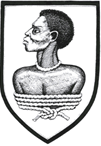 xxxxxBut Wilberforce and his associates continued their
struggle. The bill fell again in 1804 and 1805, but with the news
that Napoleon was opposed to the emancipation of slaves, the mood
changed. In February 1807 Parliament
outlawed the slave trade by a huge majority, 114 to 15. The Act
provided for the search and seizure of ships thought to be involved
in such business, and it sanctioned payment for the liberation of
slaves. Slavery remained a fact in British colonies, but it was seen
as the first step on the road to the complete abolition of slavery
as such. At the Congress of Vienna in 1814 a number of countries
followed Britain’s lead, though a few, like Denmark in 1792, had
adopted such measures many years earlier. It was to be some time,
however, before this particularly vile trade had been banned by all
European countries and - more to the point - finally
brought to an end. In Britain, a further step was taken in 1823 with
the establishment of the Society for the Mitigation and Gradual
Abolition of Slavery throughout the British Dominions. As we shall
see, these aims were achieved in 1833
(W4), just three days before the death of
the society’s chief campaigner William Wilberforce.
xxxxxBut Wilberforce and his associates continued their
struggle. The bill fell again in 1804 and 1805, but with the news
that Napoleon was opposed to the emancipation of slaves, the mood
changed. In February 1807 Parliament
outlawed the slave trade by a huge majority, 114 to 15. The Act
provided for the search and seizure of ships thought to be involved
in such business, and it sanctioned payment for the liberation of
slaves. Slavery remained a fact in British colonies, but it was seen
as the first step on the road to the complete abolition of slavery
as such. At the Congress of Vienna in 1814 a number of countries
followed Britain’s lead, though a few, like Denmark in 1792, had
adopted such measures many years earlier. It was to be some time,
however, before this particularly vile trade had been banned by all
European countries and - more to the point - finally
brought to an end. In Britain, a further step was taken in 1823 with
the establishment of the Society for the Mitigation and Gradual
Abolition of Slavery throughout the British Dominions. As we shall
see, these aims were achieved in 1833
(W4), just three days before the death of
the society’s chief campaigner William Wilberforce.
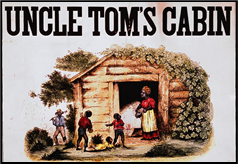 xxxxxAnd it was in that year, 1833, that the American Anti-Slavery
Society was formed in Philadelphia. As early as 1808 the U.S.
government had prohibited the import of slaves from Africa. In the
United States, however, it was a domestic not a colonial issue. The
whole question was bedevilled by the wide use of slavery in the
southern states, made the more divisive by the annexation of Texas
in 1845, a slave state of enormous size. And, as we shall see, the
anti-slave movement was given sharp impetus in 1852 with the
publication of Uncle Tom’s Cabin, an
emotional appeal by the American writer Harriet Elizabeth Beecher
Stowe. By then the United States was just ten years off the American
Civil War, a ferocious struggle fought to decide the very issue of
slavery.
xxxxxAnd it was in that year, 1833, that the American Anti-Slavery
Society was formed in Philadelphia. As early as 1808 the U.S.
government had prohibited the import of slaves from Africa. In the
United States, however, it was a domestic not a colonial issue. The
whole question was bedevilled by the wide use of slavery in the
southern states, made the more divisive by the annexation of Texas
in 1845, a slave state of enormous size. And, as we shall see, the
anti-slave movement was given sharp impetus in 1852 with the
publication of Uncle Tom’s Cabin, an
emotional appeal by the American writer Harriet Elizabeth Beecher
Stowe. By then the United States was just ten years off the American
Civil War, a ferocious struggle fought to decide the very issue of
slavery.
xxxxxMeanwhile in South America
slaves gained their freedom as each colony achieved its independence
- though it was often a freedom in name only - and slavery
was not abolished in Cuba and Brazil until the 1880s. For many
slaves, like those in the French and Dutch colonies, freedom was
still a long way off.
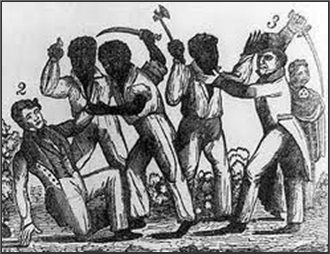
xxxxxIncidentally,
one of the biggest slave rebellions in the United States took place
in Virginia in 1831. Some 70 slaves, led by “Nat”
Turner - a Christian who believed he
was doing God’s work - went on the rampage and killed their
white masters and family members - some 60 in total. The
uprising was crushed within two days and 55 of the rebels, including
Turner, were caught and hanged. White gangs, out for revenge, then
beat, tortured and killed another 200 blacks, and Virginia and other
southern States passed new laws restricting the rights of assembly.
Acknowledgements
Sharp: detail,
by the German painter Johann Joseph Zoffany (1733-1810),
1779/81 – National Portrait Gallery, London. Clarkson: by the Swedish painter Carl Frederik von Breda
(1759-1818), 1788 – National Portrait Gallery, London. Rebellion: date and artist unknown – Rare Books and Special
Collections, Library of Congress, Washington. Wilberforce: detail, by the English portrait painter Sir Thomas
Lawrence (1769-1830), 1828 – National Portrait Gallery,
London. Slave Trade: date and artist
unknown. Holy Trinity: watercolour,
artist unknown, contained in Ecclesiastical
Topography Round London, first published in 1809.
Including:
William Wilberforce

G3c-1802-1820-G3c-1802-1820-G3c-1802-1820-G3c-1802-1820-G3c-1802-1820-G3c
xxxxxThe English philanthropist
William Wilberforce
(1759-1833) entered parliament in 1780 and, over the next 45
years, spent much of his time campaigning against the slave trade
and slavery in general. Supporting the Anti-Slavery Society
(formed in 1787) and, in particular, its members Granville Sharp and
Thomas Clarkson, he attempted many times to have a ban imposed.
Eventually, in 1792 the Commons agreed that the trade should be
“gradually” abolished but, as the French Revolution became more
violent, the matter was abandoned. A string of bills failed
throughout the 1790s, and in the early years of the 19th century,
but then the decision of Napoleon to re-impose slavery in the
French colonies turned the tide. In 1807 Parliament outlawed the slave trade by a massive
majority, and Wilberforce’s success was widely acclaimed. He retired
from the Commons in 1825, but he continued his support against
slavery and, as we shall see, just lived long enough to see slavery
abolished in all British possessions in 1833
(W4).
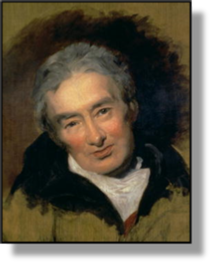 xxxxxAs we have seen, the English philanthropist and
politician William Wilberforce (1759-1833) played a leading part in the long
struggle to persuade the British government to abolish the slave
trade and slavery in general. An eloquent and persuasive orator, he
championed this worthy cause in parliament over many years and,
despite numerous setbacks, witnessed its successful conclusion just
before his death.
xxxxxAs we have seen, the English philanthropist and
politician William Wilberforce (1759-1833) played a leading part in the long
struggle to persuade the British government to abolish the slave
trade and slavery in general. An eloquent and persuasive orator, he
championed this worthy cause in parliament over many years and,
despite numerous setbacks, witnessed its successful conclusion just
before his death.
xxxxxThe son of a wealthy
merchant, Wilberforce was born in Hull, Yorkshire, in 1759, and
attended Cambridge University. It was here that he became a close
friend of William Pitt, the future Tory prime minister. They both
entered the House of Commons in 1780, where Wilberforce was soon
taking a leading part in demanding parliamentary reform and
political rights for Roman Catholics. Such was the strength of his
radical views that in 1792, at the height of the French Revolution,
he was appointed an honorary citizen of France, a title which proved
a political embarrassment as the revolution took its course. He was
obliged to support repressive measures to
prove his loyalty to king and country.
xxxxxHis support for the
anti-slavery campaign stemmed from his conversion to
Evangelical Christianity in 1784. Three years later he not only
helped to found the Anti-Slavery Society (though he did not
officially join it until 1794), but also the Proclamation Society,
an organisation aimed at reforming public morals and putting an end,
in particular, to the publication of obscenity. In that year he
wrote, "God Almighty has set before me two great objects - the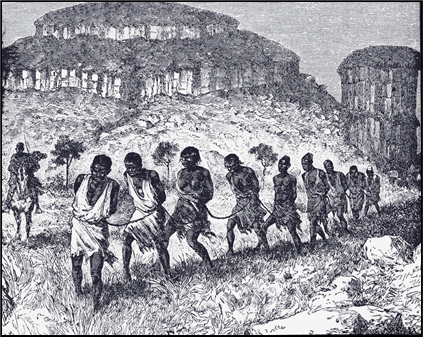 abolition of the slave trade, and the reformation of manners." In
the war against slavery he became the acknowledged leader, supported
especially by the philanthropist Granville Sharp and the cleric
Thomas Clarkson.
abolition of the slave trade, and the reformation of manners." In
the war against slavery he became the acknowledged leader, supported
especially by the philanthropist Granville Sharp and the cleric
Thomas Clarkson.
xxxxxAs we have seen,
following the failure of the 1792 bid to introduce the gradual
abolition of the slave trade - thwarted by the government’s
reactionary measures in the face of the French Revolution - and
the failure of bills throughout the 1790s, the break through came in
the early years of the 19th Century. Attempts in 1804 and 1805 fared
no better but opinion changed drastically with the news that
slavery, abolished by the French government in 1794, had been re-imposed
by Napoleon throughout the French possessions. In February 1807
the British government outlawed the slave trade by a huge majority.
It is said that emotional tributes were made to Wilberforce that
evening, and members stood to applaud his efforts. However, as we
shall see, it was to be another 25 years before his second aim, the
abolition of slavery throughout the British Dominions, was to be
realised in July 1833 (W4).
Having retired in 1825, in this achievement he was to play a
significant but less active role.
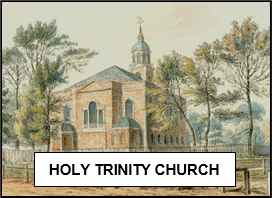 xxxxxIncidentally, when the Anti-Slavery
Society was first formed in 1787 - officially known as “The
Society for Effecting the Abolition of the Slave Trade” - its
members were derisively called “Saints”, but from 1797 they became
known as the “Clapham Sect”. This was because Wilberforce was a
member of a group of evangelical Christians centred on the Holy
Trinity Church, Clapham Common, south London, where John Venn (1759-1813),
one of the founders of the Church Missionary Society, was the
Rector. Apart from their support for the anti-slavery movement,
the members of Holy Trinity Church were also opposed to cruel sports
and gambling, worked for prison reform, and sponsored several
missionaries at home and overseas.
xxxxxIncidentally, when the Anti-Slavery
Society was first formed in 1787 - officially known as “The
Society for Effecting the Abolition of the Slave Trade” - its
members were derisively called “Saints”, but from 1797 they became
known as the “Clapham Sect”. This was because Wilberforce was a
member of a group of evangelical Christians centred on the Holy
Trinity Church, Clapham Common, south London, where John Venn (1759-1813),
one of the founders of the Church Missionary Society, was the
Rector. Apart from their support for the anti-slavery movement,
the members of Holy Trinity Church were also opposed to cruel sports
and gambling, worked for prison reform, and sponsored several
missionaries at home and overseas.






 xxxxxThe trade in
West African slaves was begun by the Portuguese as early as 1444,
during their expeditions along the west coast of Africa. The Trans-
xxxxxThe trade in
West African slaves was begun by the Portuguese as early as 1444,
during their expeditions along the west coast of Africa. The Trans-

 xxxxxIn Britain, the Quakers had campaigned against the slave
trade for many years, and had presented petitions to Parliament in
1783 and 1787. However, the first positive step was taken in 1787
with the establishment of the Society for
the Abolition of the Slave Trade. It was
formed by the English philanthropist Granville
Sharp (1735-
xxxxxIn Britain, the Quakers had campaigned against the slave
trade for many years, and had presented petitions to Parliament in
1783 and 1787. However, the first positive step was taken in 1787
with the establishment of the Society for
the Abolition of the Slave Trade. It was
formed by the English philanthropist Granville
Sharp (1735- xxxxxBut Wilberforce and his associates continued their
struggle. The bill fell again in 1804 and 1805, but with the news
that Napoleon was opposed to the emancipation of slaves, the mood
changed. In February 1807 Parliament
outlawed the slave trade by a huge majority, 114 to 15. The Act
provided for the search and seizure of ships thought to be involved
in such business, and it sanctioned payment for the liberation of
slaves. Slavery remained a fact in British colonies, but it was seen
as the first step on the road to the complete abolition of slavery
as such. At the Congress of Vienna in 1814 a number of countries
followed Britain’s lead, though a few, like Denmark in 1792, had
adopted such measures many years earlier. It was to be some time,
however, before this particularly vile trade had been banned by all
European countries and -
xxxxxBut Wilberforce and his associates continued their
struggle. The bill fell again in 1804 and 1805, but with the news
that Napoleon was opposed to the emancipation of slaves, the mood
changed. In February 1807 Parliament
outlawed the slave trade by a huge majority, 114 to 15. The Act
provided for the search and seizure of ships thought to be involved
in such business, and it sanctioned payment for the liberation of
slaves. Slavery remained a fact in British colonies, but it was seen
as the first step on the road to the complete abolition of slavery
as such. At the Congress of Vienna in 1814 a number of countries
followed Britain’s lead, though a few, like Denmark in 1792, had
adopted such measures many years earlier. It was to be some time,
however, before this particularly vile trade had been banned by all
European countries and - xxxxxAnd it was in that year, 1833, that the American Anti-
xxxxxAnd it was in that year, 1833, that the American Anti-

 xxxxxAs we have seen, the English philanthropist and
politician William Wilberforce (1759-
xxxxxAs we have seen, the English philanthropist and
politician William Wilberforce (1759- abolition of the slave trade, and the reformation of manners." In
the war against slavery he became the acknowledged leader, supported
especially by the philanthropist Granville Sharp and the cleric
Thomas Clarkson.
abolition of the slave trade, and the reformation of manners." In
the war against slavery he became the acknowledged leader, supported
especially by the philanthropist Granville Sharp and the cleric
Thomas Clarkson.  xxxxxIncidentally, when the Anti-
xxxxxIncidentally, when the Anti-

